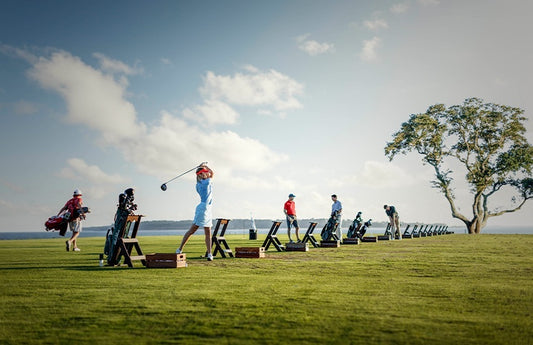When the crew from GolfBallNut is not out finding lost golf balls, we often spend our weekends doing a little golfing ourselves and introducing new folks to the sport. That was the case this past week. We gathered up a few dozen of our used golf balls and took 4 “first-timers” out on the links. There were lots of laughs, plenty of lost golf balls, and even a few impressive shots. At the end of the day, it is safe to say that the golf industry has just added 4 more participants into the fold. Just about everything went according to plan, except for one thing… the pace of our play. With new golfers, our group was playing at a very slow pace and that meant we had to let several groups “play through”. It brought up a very interesting question from the newbies… when is it appropriate to let someone play though, and when do you just keep going at your own pace?
Here we consider when and how the let through should take place and when it might not be appropriate.
WHEN YOU SHOULD LET THROUGH
When a group behind is clearly playing faster than you on a quiet course – The most clear-cut let-through scenario. Your fourball is playing a round at four-and-a-half-hour pace and a twoball appears playing at three-hour pace. You might delay your game by five minutes to let them pass but everyone will enjoy their game at the speed they’re comfortable with. Simple stuff.
And do it at the first opportunity. Don’t think, ‘we’ll let them through in a couple of holes’ or ‘we might be able to up the pace a little.’ Just take a moment to stand aside and let faster traffic pass.
If you’ve clearly lost ground on the group in front on a busier day, you should let faster groups through when appropriate to do so. Otherwise, frustration will build behind and your group will feel increased pressure – everyone will enjoy their day less as a result.
Par-3s provide a great opportunity to let groups through with minimal extra time added. Allow the group behind to play up as you reach the green, or just after you have teed off if they reach the tee quickly. Then allow them to putt out as you consider your next shots, let them move away to the next as you finish out. They will likely be nearly out of range on the next hole by the time you reach the tee.
That process can also work on longer holes. Or, let them tee off after you have, move down the hole together but then let them move ahead.
If a single player approaches, it’s very quick and easy to let them pass. They’ll be away and gone in minutes. In the dim and distant past, it used to be considered that a single player had no standing on the course – this is not the case. Accepted etiquette is that faster groups should be allowed to play through no matter the number of players in that group.
WHEN YOU SHOULDN’T LET THROUGH
If the course is simply packed out, fast groups will just have to accept that pace of play will be set. If you’re looking at groups stretching off into the distance in front of you, with no gaps to be seen, then there’s little point in letting the group behind pass, even if they’re standing with hands on hips looking fed up!
In fact, letting a group through in those circumstances will simply slow things down for the groups further behind as, inevitably, when letting even the fastest groups through, your group must remain static for at least a few extra minutes.
Having said this – It may still be beneficial from an enjoyment point of view to let the faster group pass as you might feel more relaxed in doing so. In Sub-section 4.4 of The R&A’s Pace of Play manual, it suggests:
“Sometimes, if a number of groups on the course are playing slowly, playing through does not always achieve its objective, but it remains good etiquette.”
It might just make for fewer frosty encounters in the clubhouse post round!
Lost Golf Balls traditionally results in a let-through. But it isn’t always the best way to keep play moving. With the new three-minute search Rule, if a player has a provisional ball in play and a group appears on the tee behind with, say, one minute search time left, it makes sense to complete the search and then move on to the provisional. Making the group behind wait a minute will keep play flowing far better than if your group has to wait a full 12 minutes for that group to complete the hole.
Towards the end of a round, the let-through becomes less beneficial. If you’re caught up on the 17th, the let-through will cost your group considerable time to save the group behind just a few minutes. It may also knock those playing in the group behind off their rhythm at a crucial point in their rounds.
As with most elements of life – good communication is key. If you feel any pressure from the group behind, ask them if they’d like to play through. They might say they’re very happy where they are and everyone can relax. If you feel that letting a group through would be counter-productive, explain why. Most of us are pretty reasonable and a brief, friendly chat to find the best solution will keep all satisfied – Surely that’s good etiquette.


